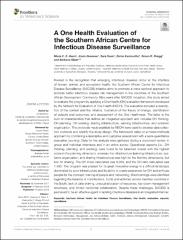A one health evaluation of the Southern African Centre for Infectious Disease Surveillance

View/
Date
2018Author
Hanin, Marie C.
Queenan, Kevin
Savić, Sara
Karimuribo, Esron
Rüegg, Simon R.
Häsler, Barbara
Metadata
Show full item recordAbstract
Rooted in the recognition that emerging infectious diseases occur at the interface
of human, animal, and ecosystem health, the Southern African Centre for Infectious
Disease Surveillance (SACIDS) initiative aims to promote a trans-sectoral approach to
address better infectious disease risk management in five countries of the Southern
African Development Community. Nine years after SACIDS’ inception, this study aimed
to evaluate the program by applying a One Health (OH) evaluation framework developed
by the Network for Evaluation of One Health (NEOH). The evaluation included a description
of the context and the initiative, illustration of the theory of change, identification
of outputs and outcomes, and assessment of the One Healthness. The latter is the
sum of characteristics that defines an integrated approach and includes OH thinking,
OH planning, OH working, sharing infrastructure, learning infrastructure, and systemic
organization. The protocols made available by NEOH were used to develop data collection
protocols and identify the study design. The framework relies on a mixed methods
approach by combining a descriptive and qualitative assessment with a semi-quantitative
evaluation (scoring). Data for the analysis were gathered during a document review, in
group and individual interviews and in an online survey. Operational aspects (i.e., OH
thinking, planning, and working) were found to be balanced overall with the highest
score in the planning dimension, whereas the infrastructure (learning infrastructure, systemic
organization, and sharing infrastructure) was high for the first two dimensions, but
low for sharing. The OH index calculated was 0.359, and the OH ratio calculated was
1.495. The program was praised for its great innovative energy in a difficult landscape
dominated by poor infrastructure and its ability to create awareness for OH and enthuse
people for the concept; training of people and networking. Shortcomings were identified
regarding the balance of contributions, funds and activities across member countries in
the South, lack of data sharing, unequal allocation of resources, top-down management
structures, and limited horizontal collaboration. Despite these challenges, SACIDS is
perceived to be an effective agent in tackling infectious diseases in an integrated manner.
